
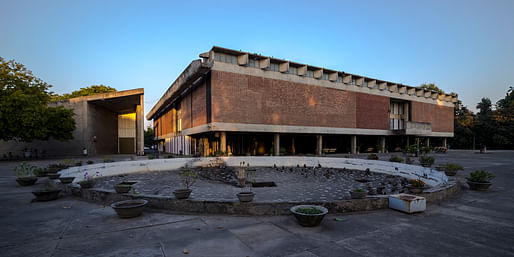
With focus on works of the twentieth century, the Getty Foundation's Keeping it Modern program awards buildings of architectural and cultural significance funding for conservation and preservation. Grants focus on the creation of conservation management plans that guide long-term maintenance and conservation policies, the thorough investigation of building conditions, and the testing and analysis of modern materials. Through their Conservation Institute, the foundation recently completed a major renovation project of Louis Kahn's Salk Institute. Twelve more buildings have been selected this year to receive a similar treatment and have been granted $1.66 million to do so including a revered Dessau structure designed by Walter Gropius that recently became listed as a World Heritage site, a Le Corbusier designed museum in India, and Boston City Hall.
Cathedral Church of St. Michael for Coventry Cathedral.
Sir Basil Spence. 1962. Coventry, England
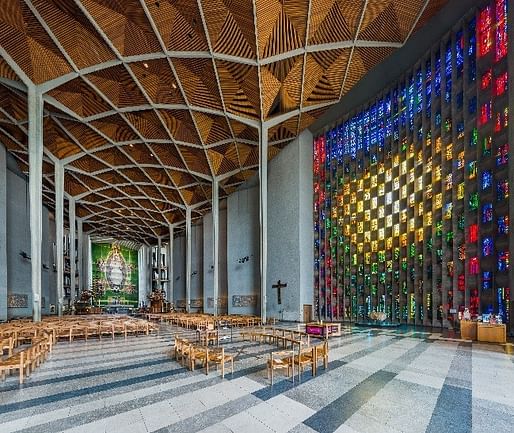
"Coventry Cathedral is both a celebrated example of 20th century architecture and a monument to the adjoined ruins of 500 year-old St. Michael's Cathedral. Consecrated in May 1962, Coventry Cathedral rapidly became a popular symbol of reconciliation in postwar Britain. Spence's design fuses St. Michael's remains with the modern structure using red sandstone walls, slender columns, minimally vaulted ceilings, and numerous bays of stained glass windows. The merging of the modern building with the ruins has resulted in a holy space where visitors and worshippers can experience the union of past and present."
The Cathedral has been granted £132,000 to work with a team of conservation specialists on creating a comprehensive conservation management plan that will address the site's much-needed repairs and prepare for long term sustainability.
City of Boston for Boston City Hall.
Kallmann, McKinnell, & Knowles. 1968. Boston, Massachusetts.

"In 1962 a panel of judges defied expectations and awarded the design of Boston City Hall to the newly established firm of Gerhard Kallmann, Michael McKinnell, and Edward Knowles to execute a bold new vision of brutalist architecture. Grandly austere with its concrete facade, Boston City Hall features several playful gestures, including its gravity-defying mayor's office that hovers over the main entrance plaza and a profusion of outsized classical dentils. The latter's ironic reference to the city's plethora of Greek-inspired municipal buildings underscores the architects' intention to introduce a new idiom to Boston's civic landscape."
$120,000 has been awarded to the City of Boston to evaluate the building and plaza, perform laboratory analysis of the concrete, and assess the building's systems.
Foundation Caisse de Dépôt et de Gestion for Sidi Harazem Thermal Bath Complex.
Jean-François Zevaco, 1958, Sidi Harazem, Morocco

"Nestled in a Moroccan oasis where ancient mineral springs have drawn visitors for centuries, the Sidi Harazem Thermal Bath Complex represents a marriage of nature, public space, and modern architecture. Built four years after Moroccan independence, the complex is the ambitious statement of a new nation determined to create modern and forward-thinking gathering places for its citizens. In 1957, a state-owned pension fund commissioned Moroccan-born French architect Jean-François Zevaco to design the site. Opened a year later to widespread acclaim, the complex is Zevaco's largest work and marks an early example of concepts that he would revisit throughout his prolific career."
Currently, only limited parts of the complex are open to the public and the grant of $150,000 has been offered to help reopen the site in its entirety.
Japan Sport Council for Yoyogi National Gymnasium.
Kenzo Tange. 1964. Tokyo, Japan
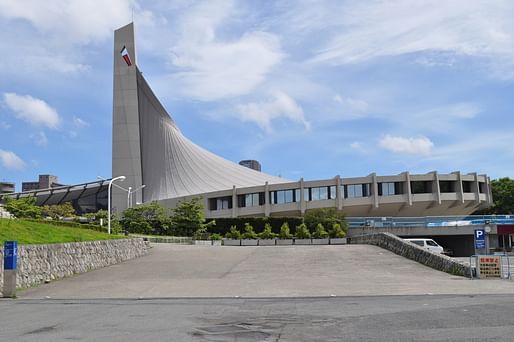
"When Japan was preparing to host the first-ever Olympic Games in Asia in the early 1960s, the state commissioned eventual Pritzker Prize-winning architect Kenzo Tange to build a pivotal venue for the event...Yoyogi National Gymnasium's state-of-the-art technology and exacting engineering, along with its elongated sweeping roofline, introduced a new modernism to Japan while still evoking the grace and timelessness of traditional Japanese architecture. With its spindle- or shell-like shape, Yoyogi National Gymnasium became a prime example of Japan's Metabolist style, a postwar Japanese movement that explored architecture as a living and evolving organism."
Japan will be hosting the Olympics in 2020 and as part of a heritage zone, the grant will be used to ensure that any interventions to the site in preparation for the Olympics will meet heritage standards.
Middle East Technical University for Faculty of Architecture Building
Altuğ and Behruz Çinici. 1963. Ankara, Turkey
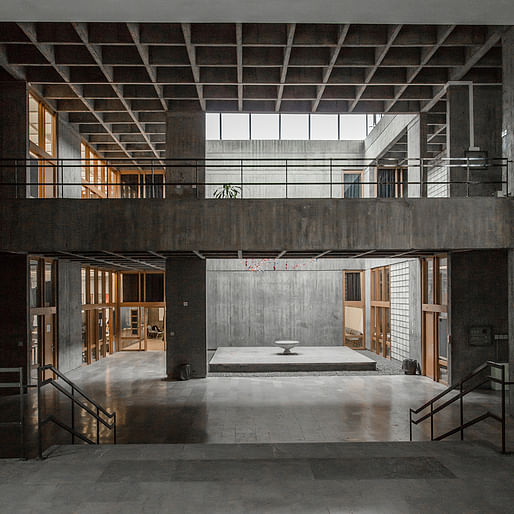
"The Middle East Technical University (METU) Faculty of Architecture Building located in Ankara is considered the premier example of modern architecture in Turkey. Originally housing administrative offices and the university's central library, the building was conceived in the 1950s to reflect a political agenda that valued innovation and new models for learning. Designed by Turkish-born architect couple Altuğ and Behruz Çinici as a manifestation of a forward-looking nation, the building incorporates striking nods to the International Style, as well as regional interpretations of modernism."
Money will be used to research and develop a long-term conservation management plan, led by the Faculty of Architecture at the University, that will also be used as a prototype for the conservation of other buildings on the campus as well.
Museu de Arte de São Paulo Assis Chateubriand
Lina Bo Bardi. 1968. São Paulo, Brazil

"An anchor of cultural life in the Brazilian city of São Paulo, the Museu de Arte de São Paulo Assis Chateaubriand (MASP) is a glass and steel tour de force. Suspended on four massive pillars, the building shell hovers 26 feet above the ground and contains a total floor area of over 110,000 square feet...Designed by Lina Bo Bardi in 1957 and completed in 1968, the museum houses one of the most important collections of Western art in the Southern hemisphere."
The Getty Foundation has granted MASP $150,000 to help support conservation and maintenance plans for long-term care.
NVA (Europe) Limited for St. Peter's Seminary
Andy MacMillan and Isi Metzstein (Gillespie, Kidd & Coia architectural practice), 1966, Glasgow Scotland
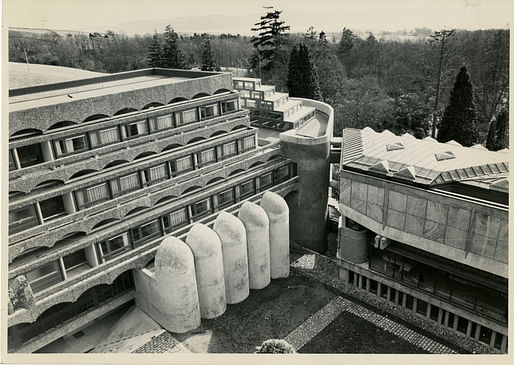
"Designed for the Catholic Archdiocese of Glasgow, St. Peter's Seminary was instantly recognized for its unabashedly brutalist use of in-situ and pre-cast panel concrete, which formed a modern homage to traditional religious forms—cloister, chapel, refectory, and cells. Architects Andy MacMillan and Isi Metzstein won the Royal Institute of British Architects' Royal Gold Medal for Architecture and earned the highest ranking of significance in Scotland for a design that artfully rearranged traditional religious spaces in unexpected ways. Yet after only 14 years of use this training college for priests was shuttered, and deteriorating conditions landed the site on the World Monuments Fund's most endangered cultural landmarks list in 2008."
Seeking a new life for the site as a performance space, cultural venue, and exhibition center, funding will go towards stabilizing and conserving the remaining structure so that adaptive reuse is made possible.
PEC University of Technology by Government Museum and Art Gallery
Le Corbusier (Charler-Édouard Jeanneret). 1968. Changdigarh, India
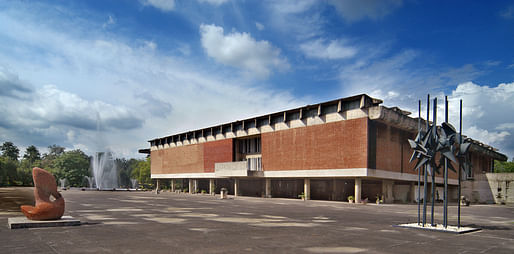
"The Government Museum and Art Gallery in Chandigarh is a pivotal work by Le Corbusier, representing the culmination of the concept he developed with Pierre Jeanneret of a museum of the future. Their 1931 idea for a "Museum of Unlimited Growth" employed the design principle of a nautilus, radiating outward from the center to create a sense of unrestricted expansion. Le Corbusier also realized this idea at the Sanskar Kendra in Ahmedabad and the National Museum of Western Art in Tokyo."
Punjab's extreme climate has caused material failure of the exterior and interior walls, putting the Grade-1 heritage site at risk. Money will go towards developing a research-based conservation management plan.
Price Tower Arts Center, Inc. for Price Tower.
Frank Lloyd Wright. 1965. Bartlesville, Oklahoma

"The sole skyscraper of influential architect Frank Lloyd Wright stands out in the prairie landscape of Bartlesville, Oklahoma. Price Tower rises 19 stories tall and remains a commanding feature of the town's modest skyline. For the interior spaces, Wright designed a mix of offices, shops, and residences that would generate revenue from residential and commercial leases. The arrangement succeeded, and the building remained in use, as designed, until its sale to Phillips Petroleum in 1981."
PTAC assumed ownership for the building in 2002 and an adaptive reuse plan for nine floors has created hotel rooms and a restaurant. While PTAC has preserved and adapted the tower for contemporary needs, additional structural and mechanical repairs are necessary.
Schusev State Museum of Architecture for Melnikov House
Konstantin Melnikov. 1929. Moscow, Russia
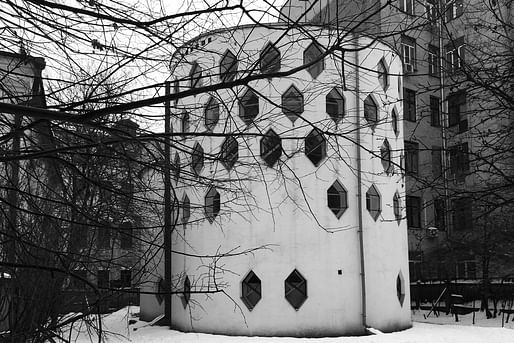
"Moscow's Melnikov House is a superlative example of Soviet avant-garde architecture and a masterpiece of structural ingenuity. Built as two intersecting cylinders, the house's unconventional style reflects the boundary-pushing vision of architect Konstantin Melnikov, who designed the house as his studio and family residence. Two generations of the family lived in the building until the death of the architect's son in 2006, and the property was transferred to the state in 2011 to be operated as a museum."
A developed conservation plan for the site is needed as there is renewed interest in the home. The plan will also serve as a model for best practice for other avant-garde monuments in Russia from the same time period.
Stiftung Bauhaus Dessau for Bauhaus building
Walter Gropius. 1925. Dessau, Germany

"Walter Gropius's 1925 Dessau Bauhaus building is an icon of the modern movement: a sleek steel, concrete, and glass structure designed to house the most progressive school of art and architecture of the time. The building is both a clear statement of Gropius's visionary aesthetic and a monument to some of the 20th century's most influential artists, architects, and designers who served as Bauhaus faculty."
Money will go towards researching new technical studies of original paint colors, analyses of character-defining features such as steel-glass window constructions and nickel plated fixtures, and explorations into the use of experimental materials that are no longer produced today.
Universitá degli Studi di Roma "La Sapienza" for Stadio Flaminio
Pier Luigi Nervi. 1960. Rome, Italy
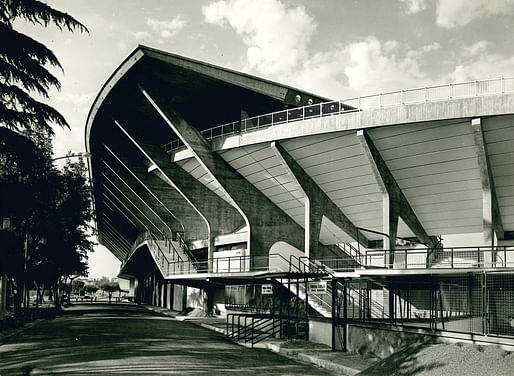
"Designed for the 1960 Olympic Games in Rome, the Stadio Flaminio is one of Pier Luigi Nervi's most celebrated buildings. Nervi was a prolific architect and engineer, who explored the boundaries of reinforced concrete with daring technological innovations and expressive concepts. By creating an arena that could hold 45,000 people, Nervi succeeded in a structural engineering feat for the time—transforming concrete into gravity-defying forms."
€161,000 will go to the Municipality of Rome for the development of a conservation plan to guide the restoration and revitalization of the stadium, which was decommissioned in 2011.
1 Comment
Wonderful article and wonderful news of these grants!
Thanks to all concerned in making the grants happening and for the reporting.
Block this user
Are you sure you want to block this user and hide all related comments throughout the site?
Archinect
This is your first comment on Archinect. Your comment will be visible once approved.